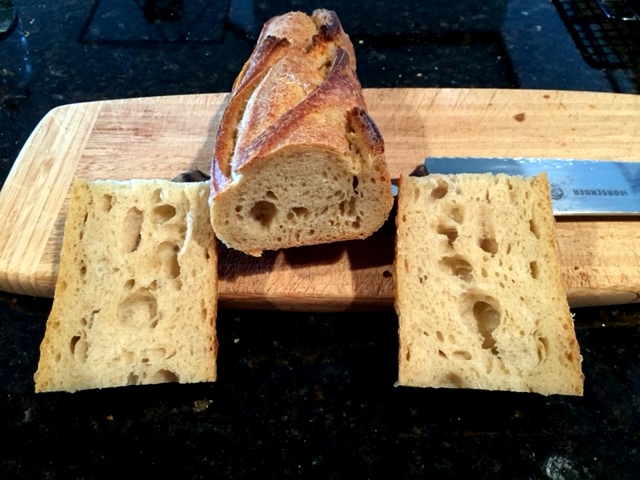Okay, so I'm playing fast and loose with the name. It is actually a durum with rye levain. Which has its roots in TFL's whirlwind tour this past Spring of the bread within the high walls of Altamura in Apulia Italy, and David Snyder's formula. I thought about this a few days ago when I posted my question: at what point does dough become bread? and used pictures from my completely untraditional and blasphemous shaping of the bread, used kinda as a demo of the before, during and after.
Anywho, it reminded me to try this formula again with a few more twists. Instead of using the 3 stage build of a 60% hydration durum levain, I instead used a 60% hydration 3 stage build with rye flour and bumped the overall hydration to 70% and holding back some water until after the autolyse. As I was due to refresh my stiff starter anyway - last refreshed in early April, I steered away from my own instructions and built each stage using the full output from prior stages. This introduced ~11% rye to the remaining 89% durum.
Baguettes are 2x400g, Batard is 1x650g.
Semolina with Rye Levain
By alfanso, roots in David Snyder’s Pane di Altamura
Aug 4, 2016
Timing
Day 1 – Mix Rye Levain - 15 minutes x 3 (18-21 hours / overnight)
Day 2 – Autolyse, Mix, Ferment, Retard – 3 Hours (Retard overnight)
Day 3 – Divide, Shape, Retard, Bake – 2 hours total (Shape – ~20 minutes, bake including firing up oven ~1.5 hours)
Rye Levain
Ingredients | Baker's % | Wt (g) | Wt (g) +25% | Wt (g) +50% |
Rye flour | 100 | 58 | 72 | 86 |
Water (80-90dF) | 60 | 35 | 43 | 52 |
Active starter @60% hydration | 40 | 23 | 29 | 35 |
Total | 200 | 116 | 144 | 173 |
Final Dough
Ingredients | Wt (g) | Wt (g) +25% | Wt (g) +50% |
Fine durum flour (semolina rimaccinata) | 500 | 625 | 750 |
Water | 356 | 445 | 534 |
Salt | 11.2 | 14 | 16.8 |
Rye Levain (60% hydration) | 100 | 125 | 150 |
Total | 967 | 1209 | 1451 |
Total Dough
Ingredients | Baker's % | Wt (g) | Wt (g) +25% | Wt (g) +50% |
Fine durum flour (semolina rimaccinata) | 89 | 500 | 625 | 750 |
Rye flour | 11 | 62 | 78 | 93 |
Water | 70 | 393 | 491 | 590 |
Salt | 2 | 11.2 | 14 | 16.8 |
Total | 172 | 966 | 1208 | 1450 |
Method
Day 1 (into Day 2).
- 1st stage of build: Rye and water to rye starter. Will not show any/much growth for majority of time (~12 hours).
- 2nd stage of build: Rye and water to rye levain. Will grow ~50%, (~4-5 hours).
- 3rd stage of build: Rye and water to rye levain. Will grow ~50%, (~3-4 hours).
Repeat twice more using 20% of the prior build as input to next build.
Day 2
- Mix flour and most water in large bowl. Hold back a few grams of water. Autolyse 1 hour.
- Add remaining water, salt and rye levain to bowl. Pinch and fold, then…
- 200 French Folds.
- Cover and rest 10 minutes.
- 200 French Folds. Dough remains quite stiff and rubbery throughout.
- Transfer dough to an oiled bowl and cover.
Bulk Ferment for total of 80 minutes (at 78-80dF) with Letter Folds at 20, 40, 60 & 80 minutes. The dough should double in volume and feel soft and puffy. Retard overnight.
Day 3
- Divide, pre-shape and shape dough in morning. Couche and retard again.
- Pre-heat oven for ~45 minutes at 500ºF with baking stone, add Sylvia’s Steaming towel 15 minutes prior to loading dough.
- Transfer loaves to a peel and score.
- Turn the oven down to 450ºF, load dough, steam the oven (near boiling water in pan of lava rocks).
- Bake with steam for 13 minutes.
- Remove steam source from oven. Bake for another 15-22 minutes depending on loaf size.
- Vent for 2 minutes with oven off.
- Transfer the loaf to a cooling rack and cool thoroughly before slicing.




Next morning crumb shot added just before toasting
